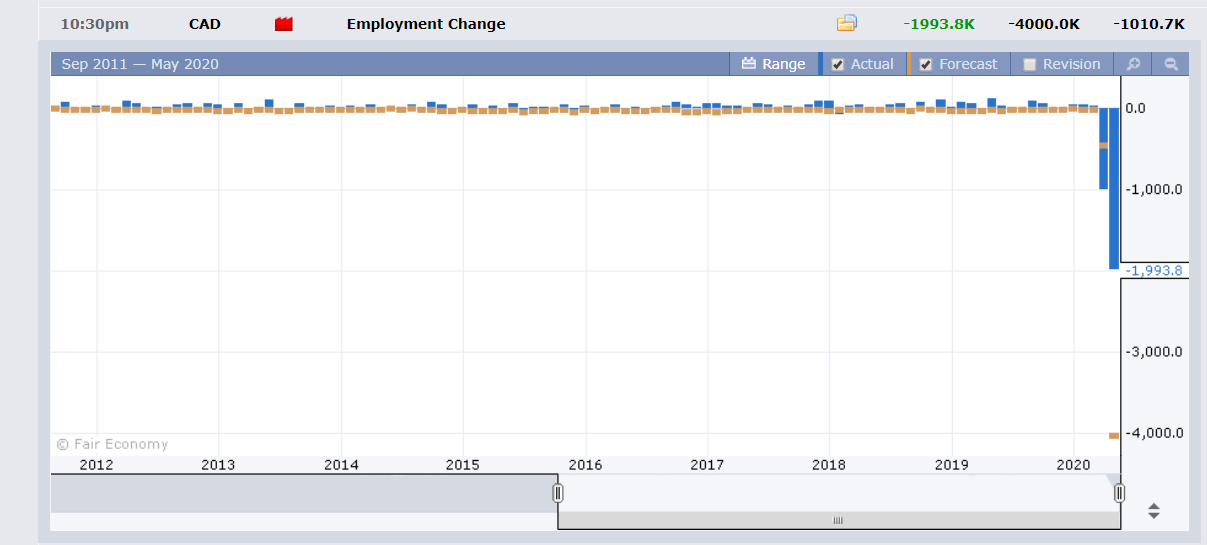Summary: The Dollar eased in muted trade after the Labour Department reported the US economy lost a staggering 20.5 million Jobs in April. It was the steepest drop in payrolls since the Great Depression. The Unemployment rate rose to 14.7% from 4.4% in March. Though dire, the numbers were smaller than economists had forecast, 21.5 million job losses, and a 16% jobless rate. Risk appetite turned positive as markets focussed instead on the reopening of nations after several weeks of lockdown. Sentiment though remains fragile, with traders monitoring the reopening(s) cautiously. Although we have a relatively light Monday, the week ahead sees a data deluge with some FOMC members speaking on the economic outlook amidst Covid-19. The beleaguered Euro finished with moderate gains on the broad-based US Dollar weakness to 1.0840 from 1.0830. Former ECB Vice President Vitor Constancio said that the European Central Bank has responded well to the German Court ruling on the ECB’s bond buying program. Sterling rallied to 1.2410 from 1.2365. On Sunday, UK Prime Minister Boris Johnson said that there would be no immediate end to the lockdown as he unveiled a conditional plan to reopen on Wednesday. The Australian Dollar extended its rally, gaining a further 0.29% against the Greenback to 0.6530 (0.6495). The Kiwi was up 0.4% to 0.6130 (0.6087) ahead of Wednesday’s (13 May) Reserve Bank of New Zealand policy meeting and rate statement. The RBNZ is widely expected to keep its OCR (Overnight Cash Rate) unchanged after slashing the rate by 0.75%, to 0.25% in March. Asian and Emerging Market currencies all saw gains versus the US Dollar. Against the Thai Baht, the Dollar lost 0.4% to 32.20 (32.40). Wall Street stocks rallied. The DOW finished up 1.73% to 24,430 (23,985) while the S&P 500 finished 1.54% higher to 2,938. (2,892). The yield on the benchmark US 10-Year treasury note rose four basis points to 0.68%. Germany’s 10-year Bund yielded -0.53% from -0.55% Friday.
Other data released on Friday saw Germany’s Trade Surplus slump to +EUR12.8 billion from +EUR 21.6 billion. Canada’s Payrolls plunged to -1,993.8 million from -1,010.7 million, although it was better than forecasts of -4.0 million. The Unemployment rate climbed to 13.0% from 7.8% but bettered forecasts of 16.0%.

On the Lookout: Spotlight falls on the data deluge in the week ahead of us, Fedspeak, and the progress of the reopening of nations from the Covid-19 lockdown. Monday kicks off with limited data released amidst risk-on although sentiment is still fragile.
China’s central bank signalled more policy measures so support its coronavirus ravaged economy. In the US, top economic advisor Larry Kudlow told the ABZ’s “This Week” program that the White House had begun informal talks with Democrats and Republicans in Congress about more Covid-19 economic relief legislation.
Today kicks off with New Zealand’s Electronic Card Retail Sales report for April as well as ANZ’s Business Confidence Index. Chinese New Loans for April and Japanese Leading Indicators as well as the BOJ’s Summary of Opinions round up Asia’s data releases. Europe sees Italy’s Industrial Output.
Tomorrow (12 May) sees US Headline and Core CPI reports. FOMC members Quarles and Harker are scheduled to speak. The RBNZ policy rates meeting and Monetary Policy Statement as well as UK GDP and US PPI are Wednesday’s (13 May) main events.
Thursday (14 May) sees Australia’s Employment report, and New Zealand’s Annual Budget release.
Friday sees US Headline and Core Retail Sales.
Trading Perspective: Expect a muted start to FX trade in Asia. While markets closed on Friday with a risk-on stance, sentiment remains fragile. Traders will focus on any fresh US-China trade headlines.
While the Dollar ended on a weak note on Friday, it will need fresh impetus to drive it much lower. In the current environment we can expect the currencies to consolidate with a short-term pullback in the US Dollar likely.














